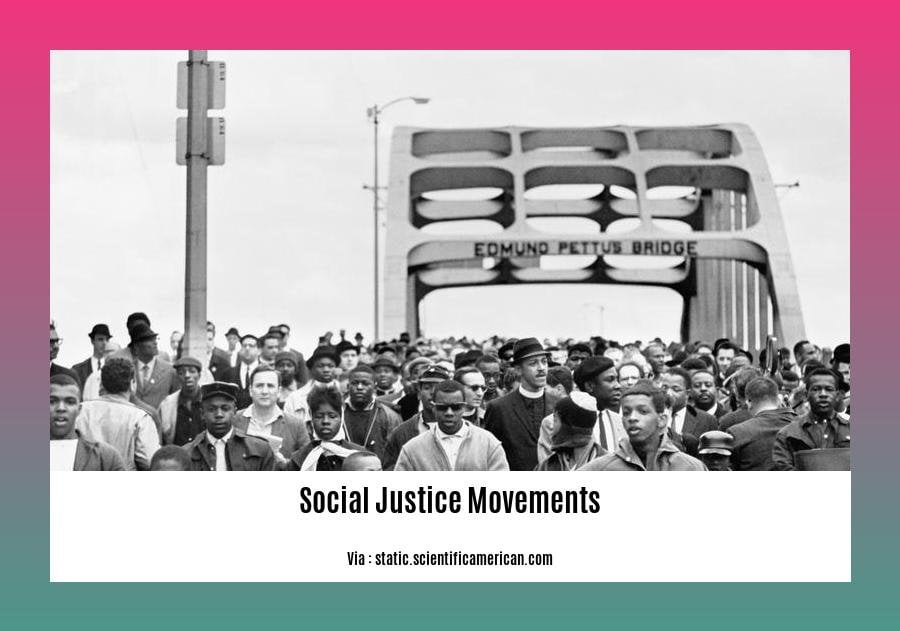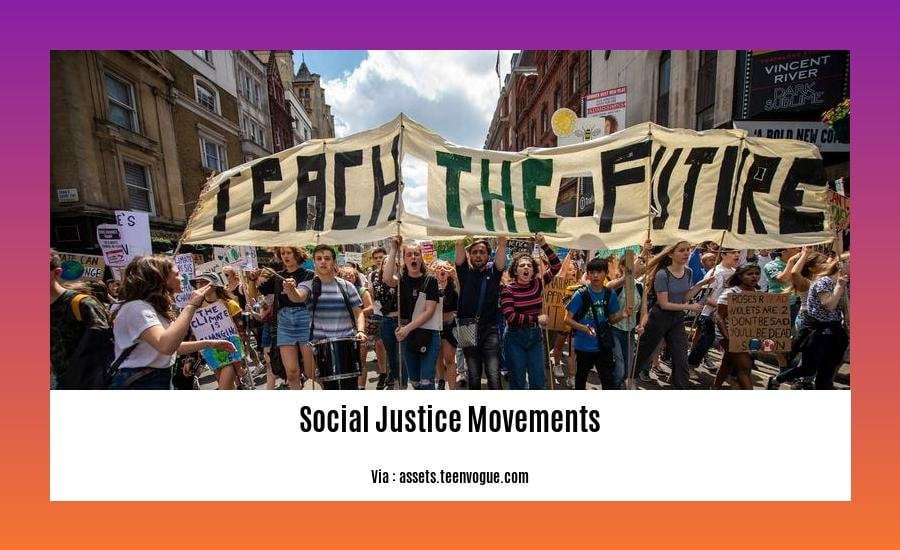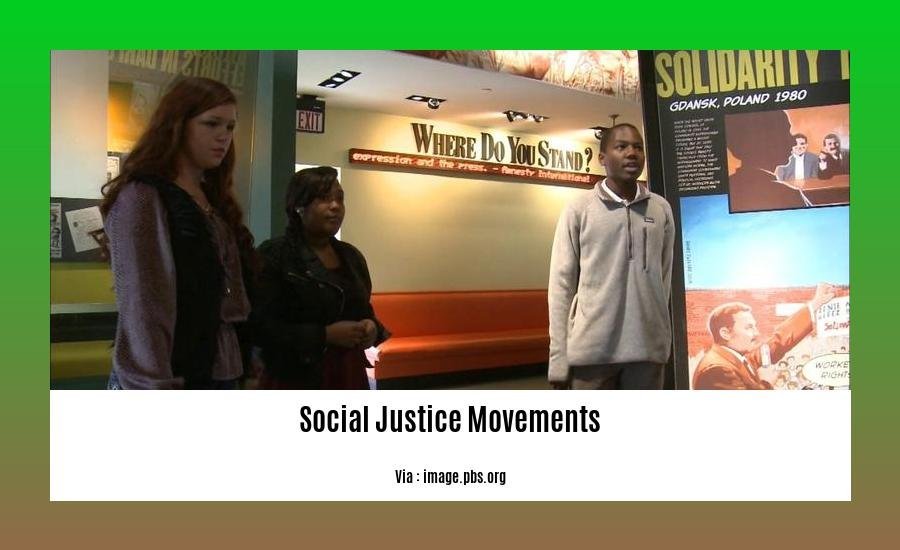In “The Power of Collective Action: Social Justice Movements Transforming Society,” we explore the profound impact of collective action in driving social justice and equity. Witness how social justice movements ignite hope, inspire change, and empower communities to overcome systemic barriers and create a more just and inclusive world.
Key Takeaways:
- Social justice movements aim to improve the lives of marginalized communities.
- Anyone can contribute to social change by participating in social justice movements.
- Social justice movements have successfully driven significant social, political, and economic reforms.
Social Justice Movements

Social justice advocates strive for equality, equity, and inclusion for people facing oppression or marginalization. These movements encompass a wide range of issues, including racial justice, LGBTQ+ rights, environmental protection, and gender equality. They have played a pivotal role throughout history, leading to transformative social, political, and economic reforms.
Key Principles
At the heart of social justice movements lie principles such as:
– Equality: The belief that all individuals deserve the same rights, opportunities, and treatment, regardless of their race, gender, sexual orientation, or other characteristics.
– Equity: Recognizing differences between individuals and groups and ensuring that resources and opportunities are distributed fairly.
– Inclusion: Creating a society where everyone feels valued, respected, and welcome.
– Self-determination: Empowering individuals and communities to make decisions about their own lives and futures.
Strategies and Tactics
Social justice movements employ diverse strategies and tactics to achieve their goals, including:
- Protest and Civil Disobedience: Public demonstrations, marches, and nonviolent resistance are used to raise awareness, demand change, and challenge unjust laws.
- Grassroots Organizing: Building community-based support through meetings, workshops, and local action.
- Political Engagement: Lobbying, voting, and running for office to influence policy and decision-making.
- Education and Awareness Raising: Distributing information, holding workshops, and using social media to inform the public about social justice issues.
- Legal Advocacy: Using the legal system to challenge discrimination, protect rights, and hold perpetrators accountable.
Impact and Legacy
Throughout history, social justice movements have brought about profound societal change. They have:
- Ended Segregation: The Civil Rights Movement fought for racial equality and ended legal segregation in the United States.
- Secured LGBTQ+ Rights: The LGBTQ+ Rights Movement has led to significant advancements in marriage equality, anti-discrimination laws, and acceptance of gender diversity.
- Protected the Environment: The Environmental Justice Movement has raised awareness about the disproportionate impact of environmental pollution on marginalized communities.
- Empowered Women: The Women’s Rights Movement has fought for equal rights, opportunities, and representation for women.
- Challenged Oppressive Regimes: Social justice movements have toppled dictatorships, promoted democracy, and fought against human rights abuses worldwide.
Challenges and Obstacles
Social justice movements often face challenges and obstacles, including:
- Resistance and Backlash: Opponents of social justice may resist change, spread misinformation, and enact policies that harm marginalized communities.
- Limited Resources: Movements often rely on volunteers and limited funding, which can hinder their ability to mobilize and sustain campaigns.
- Systemic Barriers: Deeply ingrained societal structures and institutions can perpetuate inequality and discrimination, making it difficult to achieve lasting change.
Future Prospects
Despite challenges, social justice movements continue to play a vital role in shaping our world. As new issues emerge and social landscapes evolve, these movements will continue to mobilize, advocate, and challenge injustice, creating a more just and equitable society for all.
Delve into the rich tapestry of social work’s legacy by exploring the history of social work, tracing the footsteps of its pioneers, early social workers who dedicated their lives to alleviating suffering. Discover the transformative role social work plays in society, empowering individuals and communities to navigate challenges and thrive.
Different types of social justice movements

Social movements are groups of people who come together to advocate for a common cause or goal. Their objectives can vary from issues like environmental protection to civil rights and many more. These movements are often organized around a set of shared values and beliefs, and they use a variety of strategies to achieve their goals, such as protests, lobbying, and boycotts.
One of the key aspects of social movements is that they are often driven by a sense of injustice or inequality. People who are part of these movements believe that the current system is not working for them and that they need to take action to change it.
There are many different types of social justice movements, each with its own unique goals and strategies. Some of the most common types of social justice movements include:
- Civil rights movements: These movements fight for the rights of marginalized groups, such as people of color, women, and LGBTQ+ people.
- Environmental justice movements: These movements fight for the protection of the environment and the health of communities that are disproportionately affected by pollution and other environmental hazards.
- Labor movements: These movements fight for the rights of workers, such as fair wages, safe working conditions, and the right to organize unions.
- Peace movements: These movements fight for the end of war and violence.
- Women’s rights movements: These movements fight for the rights of women, such as the right to vote, the right to reproductive choice, and the right to equal pay.
These are just a few examples of the many different types of social justice movements that exist. Each of these movements has its own unique history, goals, and strategies, but they all share a common goal of creating a more just and equitable world for all.
Key Takeaways:
- Social justice movements are organized groups working towards a common goal.
- Different types of social justice movements include civil rights, environmental justice, labor, peace, and women’s rights movements.
- Social justice movements are driven by a sense of injustice or inequality.
- Social justice movements use a variety of strategies to achieve their goals, such as protests, lobbying, and boycotts.
Citation:
Strategies and Tactics Used by Social Justice Movements
Over the years, social justice movements have developed a host of strategies and tactics to advocate for change. In the face of systemic barriers, these movements have harnessed diverse approaches to mobilize people, raise awareness, and challenge injustices. Let’s explore some of the key strategies they employ:
Grassroots Organizing:
Social justice movements often emerge from the grassroots, where people come together at the local level to address issues that affect their communities. This can involve forming community groups, holding public meetings, and mobilizing volunteers to raise awareness and advocate for change.
Civil Disobedience:
Civil disobedience involves nonviolent actions that deliberately break the law to highlight injustice and bring about change. Historically, this tactic has been used in movements such as the Black civil rights movement and the anti-war movement to challenge discriminatory laws and policies.
Boycotts and Strikes:
Social justice movements have also effectively used economic pressure to advance their goals. Boycotts involve refusing to buy goods or services from companies or institutions that support oppressive practices, while strikes involve organized work stoppages to demand better working conditions or social change.
Direct Action:
Direct action encompasses a range of tactics that involve confronting the source of injustice directly. This can include sit-ins, blockades, and occupations, all aimed at disrupting business-as-usual and pressuring decision-makers to address the issues at hand.
Online Activism:
In the digital age, social justice movements have embraced online platforms to mobilize support and spread their message. Through social media, crowdfunding, and online petitions, activists have been able to connect with a wider audience and amplify their voices.
Key Takeaways:
- Social justice movements employ a diverse range of strategies to advocate for change.
- Grassroots organizing, civil disobedience, and boycotts are some of the key tactics used to mobilize people and challenge injustices.
- Direct action and online activism have become increasingly common in recent years, offering new ways to spread awareness and pressure decision-makers.
- Despite the challenges they face, social justice movements continue to be a powerful force for positive change.
Most Relevant URL Source:
- Scientific American: From Civil Rights to Black Lives Matter
The impact of social justice movements on society
Social justice movements have played a pivotal role in shaping our societies, leaving an enduring mark on the course of history, and continuing to inspire ongoing struggles for equality, equity, and justice.
Some of the most notable social justice movements include:
- The Women’s Right to Vote Movement
- The Civil Rights Movement
- The LGBT Rights Movement
- Internal Resistance Against Apartheid Movement
- The Environmental Movement
These movements have fought tirelessly against various forms of discrimination and oppression, advocating for the rights of marginalized groups, and challenging unjust systems and structures. Their collective actions have resulted in significant societal transformations, from securing voting rights for women to ending racial segregation, legalizing same-sex marriage, and raising awareness about environmental issues.
Key Takeaways:
- Social justice movements aim to create a more just and equitable society for all, regardless of race, gender, sexual orientation, or other marginalized identities.
- They employ various strategies to achieve their goals, including protests, grassroots organizing, political engagement, and legal advocacy.
- Social justice movements have made significant historical impacts, leading to the expansion of civil rights, the recognition of human rights, and the improvement of living conditions for marginalized communities.
- They continue to play a vital role in shaping public discourse, challenging inequalities, and fostering social progress.
Citation:
– Global Citizen
FAQ
Q1: What are key characteristics of social justice movements?
Q2: How do social justice movements typically evolve and progress?
Q3: What are some notable examples of successful social justice movements?
Q4: How has social media impacted the strategies and effectiveness of social justice movements?
Q5: What are some challenges that social justice movements often face?
- China II Review: Delicious Food & Speedy Service - April 17, 2025
- Understand Virginia’s Flag: History & Debate - April 17, 2025
- Explore Long Island’s Map: Unique Regions & Insights - April 17, 2025
















